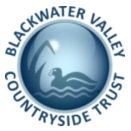From lakes to woodland, this is a great walk for bird spotting.
About the walk
Start point: Horseshoe Lake car park, Mill Lane, Yateley. SU 820620
Distance: 6 km / 3.5 miles
Walk time: 1 hour 45 minutes
Terrain: Some slopes and uneven ground, can be wet and muddy.
Getting there
Rail to Trail: from Crowthorne Station, turn right along footpath past modern offices. At railway bridge turn left and then right to follow fenced path beside sports field. Just after entering woodland turn right through metal gate to cross railway line, into Ambarrow Hill. Continue until just before road turns left signed 'Ambarrow Court' leading to car park. Cross the A321 and take the path straight onto Ambarrow Lane. Start walk at point 9.
Moor Green Lakes Nature Reserve
Horseshoe Lake, which covers about nine hectares, is named after its horseshoe-shaped island. The site is part of an extensive network of gravel pits that have now been flooded and offer a range of watersports to people of all abilities. The lake is also home to a wide variety of birds, including winter visitors and breeding birds.
- 1. From the car park turn left and follow the path to the boardwalk, then bear right to join the Blackwater Valley Path. Follow the Path keeping the river to your left and a series of lakes to your right. The first lake is Horseshoe Lake, next comes Grove Lake with a bird hide available to members of the Moor Green Lakes Group.
- 2. After passing a wooden bridge over the river to the left, take a path to the right, leaving the Blackwater Valley Path which continues along the river. Continue along the path past a second bird hide, until you reach the Moor Green Lakes Nature Reserve car park.
- 3. Cross the car park and turn left into Lower Sandhurst Road. Proceed along the road, until the first turning on the right, Dell Road.
- 4. Continue along Dell Road then just beyond the second property turn right at a wooden barrier. This will take you into Finchampstead Ridges, which is an area of National Trust woodland.
Finchampstead Ridges
Finchampstead Ridges was one of the National Trust's earliest acquisitions. The first 24 hectares of woodland were purchased by public subscription in 1913 for £3,000. Prior to that it was part of the Bearwood Estate owned by Mr. John WaIter, a Berkshire MP and proprietor of The Times newspaper. In 1863 Mr. Waiter had constructed the Wellingtonia Avenue, still a splendid sight today. In more recent years, gifts of adjoining woodland have increased the area to 56 hectares, with over 60 species of birds recorded.
- 5. Follow the raised footpath next to the ditch. Continue straight along this path ignoring any turns to the left or right. Where the path rises go straight on, then the path soon descends and passes to the right of Spout Pond.
- 6. After Spout Pond continue up a slope. At the top of the slope turn right and pass through a barrier. Then turn immediately left up a rising drive, Drift Lane. Follow the lane as it bends and continue heading uphill.
- 7. At the top of the second incline, by deep ditches, turn right along a signed woodland footpath. Then where there is a gap in the trees and a steep hill off to the right, bear left along a path which soon descends steeply into a gully. Continue along the enclosed path with a field on the right, which sweeps uphill towards Beech Hill.
The 1842 Tithe map shows that Bluebell Wood has remained virtually unchanged for over 160 years. The Bluebell is native only to the lands fringing the Atlantic. It was unknown to Greek and Roman botanists of the Mediterranean region, and as the early English herbalists based their work on these classical predecessors, the Bluebell is not mentioned in British herbals before 1548, even though it was certainly abundant then. The small white bulbs of the plant were used to make glue and as they contained starch were also used to stiffen the elaborate ruffs worn by gentlefolk in Elizabethan times. Nowadays Bluebells are protected and digging up bulbs is illegal. Take care when walking as trampling the leaves can kill the plant.
Around Ambarrow
- 8. At a field gate on the right, the path widens and joins a gravel track, follow that to the left. Turn left along Ambarrow Lane and continue passing Ambarrow Lodge on the right.
Ambarrow Court was once managed as a Victorian country estate. The original house of 1855 has been demolished, but exotic species such as bamboo, large specimen trees and yew hedges from that time can still be seen. An extensive species list has been recorded at the site, with notable plants including Bluebells and associated spring woodland flowers, cuckoo flower, yellow rattle and mature cedars and Douglas firs. Important animals recorded include the stag beetle, noctule bat and glowworm.
Stag Beetles are the largest beetles in Britain. The male is easily recognised because of his mouthparts which resemble a stag's antlers. These are used to fight other males and cannot bite. The females are smaller and have very tiny antlers. Unfortunately, the number of Stag Beetles is declining in Britain, mainly due to the lack of woodland with damp decaying wood, which the females need to lay their eggs.
- 9. Where the road bears left, around a sharp corner, take the signed footpath on the right. Follow the path along a field edge. At the end of the second field cross the lane to join a gravel path which passes Horseshoe Lake. Continue through the Watersports Centre back to the car park.
